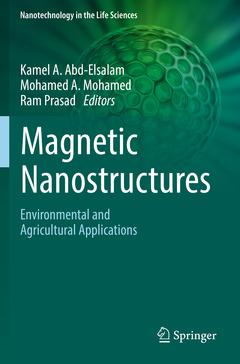Description
Magnetic Nanostructures, 1st ed. 2019
Environmental and Agricultural Applications
Nanotechnology in the Life Sciences Series
Coordinators: Abd-Elsalam Kamel A., Mohamed Mohamed A., Prasad Ram
Language: English
Subjects for Magnetic Nanostructures:
Publication date: 08-2020
Support: Print on demand
Publication date: 06-2019
329 p. · 15.5x23.5 cm · Hardback
Description
/li>Contents
/li>Biography
/li>Comment
/li>
Recently, magnetic nanostructures have gained a remarkable interest for basic research and applied studies. Because of their low cost and ease of manufacture and modification, they have great potential for agricultural and environmental applications. The use of magnetic nanostructures has been proven in a wide range of fields including catalysis, biotechnology, biomedicine, magnetic resonance imaging, agriculture, biosensors, and removal of environmental pollutants, among others.
This book includes 16 chapters of collected knowledge, discoveries, and applications in agriculture, soil remediation, and water treatment. It describes the role of nano-agriculture with regard to food security and discusses environmental and agricultural protection concerns. It further offers potential applications of magnetic nanomaterials in the agriculture and food sectors, such as the development of sensors, environment monitoring for wastewater treatment and the remediationof contaminated soils. Increasing crop yield through the use of nanopesticides or nanofertilizers and biosecurity using sensors for detecting pathogens along the entire food chain are discussed as well.
This book also brings together various sources of expertise on different aspects magnetic nanostructure application in the agri-food sector and environment remediation. Magnetic nanostructures also have great potential in biotechnological processes, as they can be utilized as a carrier for enzymes during different biocatalytic transformations. Novel magnetic nanomaterials can be used for detection and separation of pesticides from environmental and biological samples. The excellent adsorption capacity of the modified magnetic nanoadsorbents together with other advantages such as reusability, easy separation, environmentally friendly composition, and freedom of interferences of alkaline earth metal ions make them suitable adsorbents for removal of heavy metal ions from environmental and industrial wastes. One of the most important environmental applications of magnetic nanostructures has been in the treatment of water, whether in the remediation of groundwater or through the magnetic separation and/or sensing of contaminants present in various aqueous systems.
The integrated combination of these 16 chapters, written by experts with considerable experience in their area of research, provides a comprehensive overview on the synthesis, characterization, application, environmental processing, and agriculture of engineered magnetic nanostructures. Its comprehensive coverage discusses how nanostructure materials interact in plants as well as their potential and useful applications.
Preface.- Nanoparticles: Magnetism and applications.- Bio-based synthesis of magnetic nanoparticles and their applications.- Plant mediated synthesis, applications and challenges of magnetic nanostructures.- Microbially synthesized biomagnetic nanomaterials.- Nanotechnology and Nano-biotechnology for Environmental Remediation.- Magnetic nanoparticles: a unique gene delivery system in plant science.- Magnetic Nanoparticles: Eco-friendly Application in Biofuel Production.- An overview of magnetic material: preparation and adsorption removal of heavy metals from waste water.- Water Purification using Magnetic Nanomaterials: An Overview.- Metal ferrites and their graphene-based nanocomposites: Synthesis, characterization and applications in wastewater treatment.- Magnetic Nanostructures: Environmental and Agricultural Applications.- Magnetic nanoparticles in plant protection: Promises and Risks.- Application of magnetic nanoparticles for removal of pesticides from environmental samples prior to instrumental analysis.- Iron-based nanomaterials: Effect on soil microbes and soil health.- Magnetic nanoparticle interface and the antimicrobial propensity.- Antimicrobial activity of magnetic nanoparticles.- Index.



